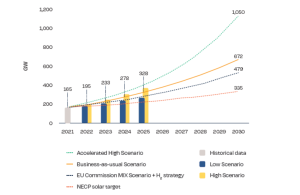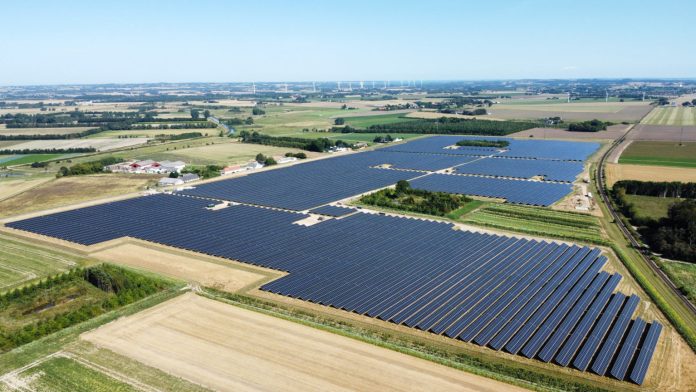SolarPower Europe has issued a list of eight actions that will help Europe accelerate solar deployment to reach a total capacity of 1TW by 2030 and reduce its reliance on Russian fossil fuel imports.
Presented to the bloc’s energy commissioner, Kadri Simson, against the backdrop of the war in Ukraine and the European energy crisis, the report said the EU would be able to add 39GW of solar PV under an “accelerated high scenario” that would see 23.3GW of rooftop solar and 15.7GW of utility-scale solar added in 2022.
Real acceleration, however, needs to happen in the medium-term, the report said. The current REPowerEU solar market projection for 2030 predicts 525GW, far below the 672GW expected by the industry under a pre-war, business-as-usual scenario. Now, a switch to an accelerated high scenario is necessary and could see PV capacity reach 1TW by 2030, said SolarPower Europe.
The first of the eight actions that will build the “necessary foundations for the European solar Terawatt age” is to accelerate existing projects already in the pipeline to ensure completion by the end the year, identify go-to areas for additional solar-plus-storage projects and set a clear EU-level target for 100GW of solar PV deployment per year from 2025.
Second, the EU should in the short-term suspend grid connection costs between 2022-24 and develop a framework for grid-friendly solar projects. Looking to the medium-turn, it could also simplify permitting processes, increase the open data obligations from TSOs and DSOs on the grid structure and develop an EU-level roadmap on grid modernisation.
Third, the bloc could “give clear signals to the electrical and mechanical installers industry” by mandating solar panels on all rooftops and banning the installation of new gas and oil boilers. Moving forward, it should also launch a skills initiative for the solar PV industry that will include funding for training and apprenticeship programmes.
Fourth, Europe should immediately deploy integrated solar applications, such as agrisolar, floating solar, and building-integrated PV. In the medium-term it should gather evidence on the benefits of floating solar and agrisolar, identify O&M solutions, create models for OPEX costs and define impacts on deliverability.

EU27 total solar PV market scenarios 2022-2030. Source: SolarPower Europe.
Fifth, the continent needs to secure supply chains and access to raw materials, which are in high demand across the sector. Following this, Europe’s solar industry should conduct a comprehensive analysis of the raw materials needed in the solar PV industry, focusing on access to silicon metal, silver, aluminium and copper. PV Tech Premium has recently taken a look at global metal markets and their impact on solar PV.
Sixth, Europe needs to reinvest in domestic manufacturing by launching a €1 billion (US$1.1 billion) ‘Solar Fund’ to leverage private investment, set a target to close financing on shovel-ready projects within six months and eliminate EU trade barriers to facilitate access to necessary components and raw materials.
Seventh, the EU should use the ‘renovation wave’ to boost the deployment of rooftop solar and frontload investments into 23.3GW of rooftop PV by the end of 2022, while easing State Aid rules to allow member states to grant public money for renovation and solar deployment.
Finally, in the short-term the bloc should ensure rooftop PV deployment is accompanied with the deployment of energy system management and local battery storage, to make rooftop PV prosumer-ready or flexibility-ready.
SolarPower Europe pointed to recent solar statistics as a reason that 1TW of solar PV by 2030 was achievable. In 2021, solar grew by 34% year-on-year to add about 26GW of generation capacity, reaching a cumulative EU solar capacity of 165GW. This was 136% more than the 11GW added by wind power and more than all other new renewable, fossil fuel and nuclear capacities combined in 2021.
The EU has already called on its nation states to accelerate solar deployment at “lightning speed” in order to reduce reliance on Russian imports, and a report from energy technology group W?rtsil? this week argued that Europe could halve the amount of gas in its energy mix and reduce energy costs by €323 billion (US$356 billion) if it rapidly accelerates renewable deployment.
The International Energy Agency (IEA) has also unveiled a 10-point plan to help the continent wean itself of Russian fossil fuels.
PV Tech Premium has reported how the war in Ukraine looks set to transform Europe’s energy apparatus as the continent looks to increase its energy independence.






